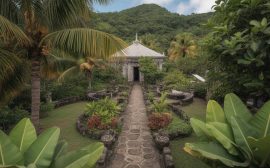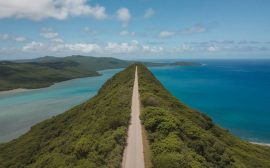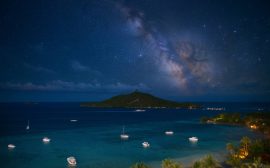Discovering Saint-Pierre: A Journey to Martinique’s Volcanic Heritage
The Caribbean island of Martinique is a destination where the azure waters of the Atlantic meet the tropical warmth of the Lesser Antilles, but it is also a land steeped in a rich and sometimes tumultuous history. At the heart of this history lies the town of Saint-Pierre, nestled at the foot of the island’s towering and still-active volcano, Mount Pelée. Today, we embark on a voyage of discovery to the ruins of Saint-Pierre, which serve as a powerful testament to the volcanic past and resilience of Martinique.
The Fateful Day of Mount Pelée’s Eruption
On the morning of May 8, 1902, Mount Pelée erupted with a force that would change the course of Martinique’s history forever. The eruption, one of the deadliest of the 20th century, obliterated the town of Saint-Pierre, once known as the « Paris of the West Indies, » and claimed the lives of over 30,000 people. The only survivor within the town, a prisoner protected by thick dungeon walls, lived to tell the harrowing tale. This catastrophic event has etched itself into the collective memory of Martinique and serves as a poignant reminder of nature’s unpredictable power.
The Archaeological Treasure of the Caribbean
In the aftermath of the eruption, the ruins of Saint-Pierre have been carefully preserved; the town has since been referred to as the « Pompeii of the Caribbean ». Walking through the streets and remains, visitors get an intimate glimpse into the daily lives of the people who once thrived here. The remnants of theaters, prisons, and bakeries tell a silent yet gripping story of the island’s cultural richness and the tragedy that befell it.
What to Expect When Visiting Saint-Pierre Today
For those wishing to explore Saint-Pierre today, the experience is both profoundly moving and insightful. The site features an array of ruins that speak to both the grandeur of the former city and the destructive forces of nature:
- The Volcanological Museum of Martinique, which offers an immersive educational experience about the volcanic activity of Mount Pelée and its impact on the island.
- The Prison Cell of Cyparis, the lone survivor of the eruption, which stands as an eerie monument to human endurance against natural calamities.
- The remnants of the Theater, an architectural marvel that once hosted grand performances, now a poignant reminder of the cultural life that was lost.
- The wreckage of the old rum distilleries, which tell the story of Martinique’s long-standing tradition in rum production and its interruption due to the eruption.
Guided tours of Saint-Pierre are available, allowing visitors to enrich their visit with the knowledge and stories that only a local expert can offer.
The Volcanic Legacy of Mount Pelée
While exploring the ruins, it becomes evident that Mount Pelée’s shadow still looms large over the town. The volcano remains an integral part of the island’s ecosystem and history. Geologically speaking, Mount Pelée is one of the most studied volcanoes in the world. Its notorious eruption led to advancements in the field of vulcanology and established the need for improved volcanic monitoring and disaster preparedness.
Today, Mount Pelée is closely monitored, and the Volcanological and Seismological Observatory of Martinique plays a key role in ensuring the safety of the island’s residents and visitors. Hiking trails up the volcano offer breathtaking views and a chance to witness the regrowth of flora and fauna that has occurred over the past century.
Respecting and Preserving the Site for Future Generations
Respect for the site and its historical significance is paramount. The ruins of Saint-Pierre are not only a major tourist attraction but also a place of remembrance for those who lost their lives in the eruption. Efforts have been made to preserve the ruins while providing educational resources to visitors. Conservation is an ongoing process, one that ensures that future generations can also learn from and appreciate this window into Martinique’s volcanic past.
Integrating Travel into Sustainable Tourism
Travelers to Saint-Pierre are encouraged to engage in sustainable tourism practices. This includes supporting local businesses and guides, which enriches the local economy and promotes responsible tourism. Staying in eco-friendly accommodations, participating in activities with minimal ecological impact, and adhering to guidelines that preserve the historical integrity of the ruins are all ways that visitors can contribute to the sustainability of this precious site.
Planning Your Visit: Essentials to Know
For those planning a visit to the ruins of Saint-Pierre, it is important to come prepared:
- Check the weather conditions, as the tropical climate can bring sudden showers and changes in temperature.
- Wear appropriate footwear for the uneven terrain of the ruins and trails.
- Consider hiring a local guide to gain deeper insights into the history and significance of the site.
- Remember to bring a camera, as the haunting beauty of these ruins against the backdrop of lush mountains and clear skies is not to be missed.
In conclusion, Saint-Pierre offers an unparalleled opportunity to explore the historical and geological narrative of Martinique. Its ruins provide a dramatic window into the past and encourage reflection on the beauty and volatility of our natural world. A visit to this site can be both a poignant reminder of the fragility of human settlements and a testimony to the enduring spirit of cultures that face the might of nature.




